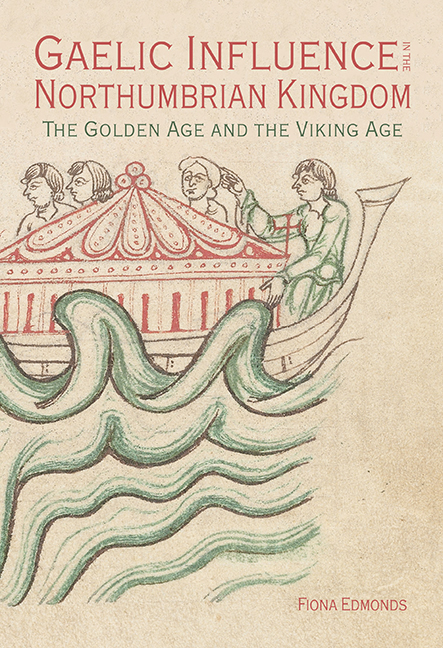Book contents
- Frontmatter
- Contents
- List of Illustrations
- Acknowledgements
- List of Abbreviations
- Preface: An Eventful Voyage
- 1 Concepts and Historiography of the Northumbrian and Gaelic Worlds: Medieval to Modern
- 2 Exiles and Emperors: Gaelic-Northumbrian Political Relations in the Golden Age
- 3 Fragmentation and Opportunity: From the Eighth Century to the Viking Age
- 4 Pathways through the Past: Routes between the Gaelic World and the Northumbrian Kingdom
- 5 A Golden Age of Ecclesiastical Contacts
- 6 Saints and Seaways in the Viking Age
- 7 Medieval Multilingualism: Gaelic Linguistic Influence in the Northumbrian Kingdom
- 8 Movement and Material Culture in the Northumbrian and Gaelic Worlds
- Conclusion: Individuals and Influences
- Bibliography
- Index
- STUDIES IN CELTIC HISTORY
6 - Saints and Seaways in the Viking Age
Published online by Cambridge University Press: 28 February 2020
- Frontmatter
- Contents
- List of Illustrations
- Acknowledgements
- List of Abbreviations
- Preface: An Eventful Voyage
- 1 Concepts and Historiography of the Northumbrian and Gaelic Worlds: Medieval to Modern
- 2 Exiles and Emperors: Gaelic-Northumbrian Political Relations in the Golden Age
- 3 Fragmentation and Opportunity: From the Eighth Century to the Viking Age
- 4 Pathways through the Past: Routes between the Gaelic World and the Northumbrian Kingdom
- 5 A Golden Age of Ecclesiastical Contacts
- 6 Saints and Seaways in the Viking Age
- 7 Medieval Multilingualism: Gaelic Linguistic Influence in the Northumbrian Kingdom
- 8 Movement and Material Culture in the Northumbrian and Gaelic Worlds
- Conclusion: Individuals and Influences
- Bibliography
- Index
- STUDIES IN CELTIC HISTORY
Summary
The voyages of saints across the Irish Sea seem to epitomise early medieval cultural contacts. Church dedications were once thought to reveal movements of churchmen during the so-called ‘Age of the Saints’, the shadowy period between the fifth century and the seventh. Scholars now take a more complex view, acknowledging the numerous chronological layers in a saint's cult. In this chapter, I contend that the foundation of new churches during the Viking Age underpinned the transmission of saints’ cults from the Gaelic world to the Northumbrian kingdom. I disentangle evidence of Viking-Age devotion from the late-medieval veneration of Gaelic saints in the area. The resulting pattern supports the argument that I have developed so far, namely, that Gaelic influence arrived in the Northumbrian kingdom from a variety of directions and over a lengthy period of time.
The study of church dedications raises two formidable problems: it can be difficult to identify the medieval dedication of a church, and it is hard to know how a church came to be dedicated to a specific saint, in an era before formal dedication ceremonies became routine. These difficulties have spawned a long and venerable tradition of Patrozinienforschung, or researching dedications, across Europe. There have long been ceremonies relating to the consecration of the church building and its dedication to God. From the fourth century onwards, an additional patron might be honoured, and this gave rise to what is now commonly described as a ‘church dedication’. Medieval bishops performed three related ceremonies: the dedication of the church, the consecration of the altar and the enclosure of relics. The role of relics in the foundation of churches is attested in both Ireland and the Northumbrian kingdom. When Bishop Colmán left Lindisfarne, he selected some relics of Saint Áedán, and transported them to the church that he founded at Inis Bó Finne (Inishbofin, Co. Mayo).
It is questionable whether all of the churches that were dedicated to Gaelic saints in the west of the Northumbrian kingdom held corporeal relics, given their number. Indeed, the Council of Chelsea (816) made provision for churches to be consecrated in the absence of relics, by sealing the Eucharist in the altar.
- Type
- Chapter
- Information
- Gaelic Influence in the Northumbrian KingdomThe Golden Age and the Viking Age, pp. 127 - 154Publisher: Boydell & BrewerPrint publication year: 2020



